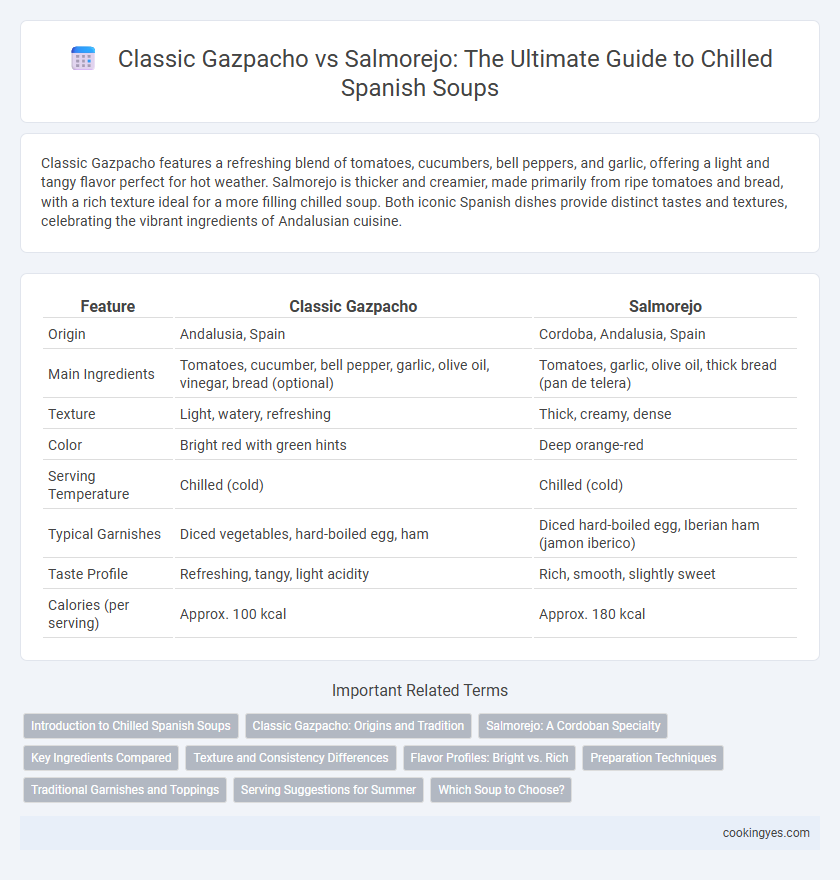Classic Gazpacho features a refreshing blend of tomatoes, cucumbers, bell peppers, and garlic, offering a light and tangy flavor perfect for hot weather. Salmorejo is thicker and creamier, made primarily from ripe tomatoes and bread, with a rich texture ideal for a more filling chilled soup. Both iconic Spanish dishes provide distinct tastes and textures, celebrating the vibrant ingredients of Andalusian cuisine.
Table of Comparison
| Feature | Classic Gazpacho | Salmorejo |
|---|---|---|
| Origin | Andalusia, Spain | Cordoba, Andalusia, Spain |
| Main Ingredients | Tomatoes, cucumber, bell pepper, garlic, olive oil, vinegar, bread (optional) | Tomatoes, garlic, olive oil, thick bread (pan de telera) |
| Texture | Light, watery, refreshing | Thick, creamy, dense |
| Color | Bright red with green hints | Deep orange-red |
| Serving Temperature | Chilled (cold) | Chilled (cold) |
| Typical Garnishes | Diced vegetables, hard-boiled egg, ham | Diced hard-boiled egg, Iberian ham (jamon iberico) |
| Taste Profile | Refreshing, tangy, light acidity | Rich, smooth, slightly sweet |
| Calories (per serving) | Approx. 100 kcal | Approx. 180 kcal |
Introduction to Chilled Spanish Soups
Classic Gazpacho features a vibrant blend of raw tomatoes, cucumbers, bell peppers, and garlic, creating a refreshing and light chilled soup ideal for hot Andalusian summers. Salmorejo, a thicker and creamier alternative, relies on ripe tomatoes, bread, garlic, and olive oil, offering a richer texture and more substantial flavor profile. Both soups highlight the regional tradition of using fresh, local ingredients to craft cooling dishes that embody Spain's culinary heritage.
Classic Gazpacho: Origins and Tradition
Classic gazpacho, originating from Andalusia in southern Spain, is a traditional chilled soup made from ripe tomatoes, cucumbers, green peppers, garlic, olive oil, vinegar, and stale bread blended into a refreshing, thin consistency. This cold soup reflects the agricultural heritage and hot climate of the region, serving as a hydrating and nutrient-rich meal during summer months. Its vibrant flavors and rustic preparation methods have cemented classic gazpacho as an iconic staple in Spanish cuisine.
Salmorejo: A Cordoban Specialty
Salmorejo, a creamy and thicker chilled soup from Cordoba, Spain, is distinguished by its rich texture made from ripe tomatoes, bread, olive oil, and garlic, offering a more indulgent experience than the traditional Classic Gazpacho. Unlike Gazpacho's light and refreshing blend of vegetables, Salmorejo's velvety consistency is enhanced with toppings like hard-boiled eggs and jamon iberico, emphasizing its Cordoban origins. This regional specialty highlights the unique culinary identity of Andalusian cuisine, balancing simplicity with robust flavor.
Key Ingredients Compared
Classic gazpacho features a vibrant blend of fresh tomatoes, cucumbers, green peppers, onions, olive oil, vinegar, and stale bread, creating a light and refreshing chilled soup. Salmorejo uses a denser base with ripe tomatoes, a larger amount of soaked bread, garlic, and olive oil, resulting in a creamier texture and richer flavor. The primary distinction lies in the bread-to-tomato ratio and the inclusion of garlic, making gazpacho more watery and tangy, while salmorejo is thicker and smoother.
Texture and Consistency Differences
Classic gazpacho offers a light, watery texture made from blended raw vegetables like tomatoes, cucumbers, and peppers, providing a refreshing and thin consistency ideal for hot weather. In contrast, salmorejo features a much thicker, creamier texture due to its heavy use of bread and olive oil, resulting in a dense, smooth consistency that feels rich and velvety. These texture and consistency differences define their unique roles in Spanish cuisine, with gazpacho emphasizing hydration and freshness, while salmorejo highlights indulgence and depth.
Flavor Profiles: Bright vs. Rich
Classic gazpacho features a bright, tangy flavor profile with fresh tomatoes, cucumbers, and bell peppers, creating a refreshing and light chilled soup. In contrast, salmorejo offers a richer, creamier taste due to its higher olive oil content and the addition of stale bread, resulting in a thicker texture and deeper tomato flavor. Both soups highlight the essence of Spanish cuisine but cater to different palate preferences: gazpacho with its crisp acidity and salmorejo with its smooth, savory richness.
Preparation Techniques
Classic gazpacho is prepared by blending raw vegetables such as tomatoes, cucumbers, bell peppers, garlic, and onions with olive oil, vinegar, and bread soaked in water for a lighter, more liquid texture. Salmorejo, on the other hand, emphasizes a denser consistency achieved by pureeing ripe tomatoes with soaked bread, garlic, and a generous amount of olive oil, creating a creamy and thick soup. Both techniques highlight the use of fresh ingredients and olive oil, but salmorejo's preparation involves fewer vegetables and a longer emulsification process for its signature smooth texture.
Traditional Garnishes and Toppings
Classic gazpacho features traditional garnishes such as diced cucumber, bell pepper, red onion, and hard-boiled egg, enhancing its refreshing, light texture. In contrast, Salmorejo is typically topped with finely chopped Iberian ham and hard-boiled egg, providing a richer, creamier complement to its thicker consistency. Both chilled Spanish soups highlight regional flavors through their distinctive toppings, reflecting Andalusian culinary heritage.
Serving Suggestions for Summer
Classic gazpacho serves as a refreshing, thin tomato-based soup often garnished with diced cucumber, bell peppers, and croutons, making it ideal for hydration and light summer meals. Salmorejo presents a thicker, creamier texture enriched with olive oil and egg, typically topped with hard-boiled eggs and jamon serrano for a richer, more filling option. Both chilled soups excel as cooling dishes during hot weather, with gazpacho favored for its crispness and salmorejo suited for indulgent, protein-rich servings.
Which Soup to Choose?
Classic gazpacho features a light, refreshing blend of tomatoes, cucumbers, bell peppers, and garlic, making it ideal for those seeking a low-calorie, hydrating chilled soup. Salmorejo offers a thicker, creamier texture with concentrated flavors from ripe tomatoes, bread, olive oil, and garlic, suited for a richer, more filling option. Choose classic gazpacho for a crisp, vegetable-forward experience, or salmorejo for a hearty, velvety alternative that pairs well with toppings like hard-boiled eggs and serrano ham.
Classic Gazpacho vs Salmorejo for chilled Spanish soups Infographic

 cookingyes.com
cookingyes.com